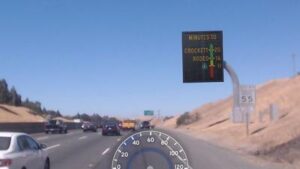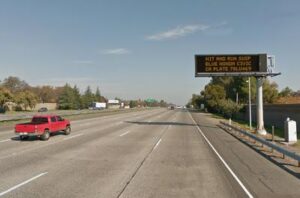Human Factors Research
Brief Overview of Human Factors Projects in California PATH
Peggy Wang and Ching-Yao Chan, California PATH
Updated in February 2019
According to the domain of the research, the most recent human-factors projects could be divided into two categories as (1) intelligent transportation system related and (2) automated driving system related. Please contact Peggy Wang for more information.
I. INTELLIGENT TRANSPORTATION SYSTEM RESEARCH:
There are two projects in this category. One is” Information Display Board for Corridor Management in California”. The other one is “Safety Effect of Yellow Alert Changeable Message Sign”.
I.1 Information Display Board for Corridor Management in California

Information Display Board

Information Display Board
Background: California Department of Transportation (Caltrans) has proposed to display graphical message and text message to convey additional traveler information in order to enhance drivers’ knowledge of the downstream traffic condition, alternative routes and transportation modes. The IDB uses full color and full matrix LED technology to show dynamic message signs. Five types of signs are investigated, including (1) Travel time messages; (2) Transit agency logos for transit travel times; (3) Special messages; (4) Graphic route information panel (GRIPs), and (5) Up to six lines message.
Goal: The goal of this project was to develop IDBs that are easily comprehensible and that convey information in an instructive and helpful manner to the traveling public. It was also a primary goal to seek FHWA approval for experimental use of certain text and graphical images on the IDB. Moreover, the evaluation of IDBs in this case study can potentially be extended to other corridors in California and eventually around the country.
Technical approach: A three-stage systematic approach was proposed in order to meet the objectives of this project, which includes: Stage 1: lab testing and simulator testing; Stage 2: Field testing; and Stage 3: focus group discussion.
Current status and report: So far, we have completed the lab testing and simulator testing. The final report of the lab testing and simulator testing are available for sharing upon request.
I.2 Safety Effect of Yellow Alert Changeable Message Sign

Yellow Alert Changeable Message


Yellow Alert Changeable Message
Background: Yellow Alert is a message system proposed by Caltrans to issue and coordinate public alert following major injury and fatal hit-and-runs. One concern is that this type of message on CMS may distract drivers if they look for the subject vehicles or change their driving behavior to examine or report suspicious vehicles.
Goal: The primary objective of this project was to identify and evaluate the safety effects of the Yellow Alert CMS, which included the following three research questions: (1) Question #1: Are there potential safety impacts of Yellow Alert on CMS? (2) Question #2: What will be drivers’ responses when they read and after they read the Yellow Alert CMS? (3) Question #3: After drivers read the Yellow Alert, how will they change their driving behaviors in order to help?
Technical approach: In order to answer Question #1, in-depth and comprehensive literature review have been conducted to get reference of safety effect of CMS emergency alert displays in academia, state DOTs, and FHWA, etc. In order to answer Question #2 and Question #3, we proposed a two-stage plan, a survey and a simulation experiment.
Current status and preliminary findings: A TPB (Theory of Planned Behavior) model was used to develop the survey questionnaire. Before the survey, we completed the elicitation interview. Based on results from the interview, all interviewees understood the message well. Most interviewees would not try to retain the information for later reference. Most interviewees would keep an eye out for the suspect vehicle while driving. If a vehicle matches the description of the suspect vehicle, more than half of the interviewees would try to get behind of the vehicle in order to exam its license plate number. More than 45% of the interviewees would call 911 while driving in order to report a suspect vehicle. The current stage of this project is to implement the survey on an online platform (e.g., Survey Monkey).
II. AUTOMATED DRIVING SYSTEM RESEARCH:
There are also two projects in this category. One is the “User Acceptance and Public Policy Implications for Deployment of Automated Driving Systems”, funded by the California State as directed in the Road Repair and Accountability Act (SB 1) passed in April 2017. The other project is “Interaction and Communication Between Pedestrians and Autonomous Vehicles”, funded by Berkeley Deep Drive.
II.1 User Acceptance and Public Policy Implications for Deployment of Automated Driving Systems
Fully Automated Driving System Capabilities

Fully Automated Driving System Capabilities
Background: Research has shown that automated driving systems (ADS) have the potential to improve road safety and efficiency of road transportation. However, many challenges are yet to be addressed for ADS and self-driving cars. One of these challenges is public perception and public policy, which is vital to determine the extent to which people will accept and pay for automated driving technologies.
Goal: The goal of this project was to understand public perception of ADS and develop an acceptance model that can help understand users’ intentions to accept and use of the ADS. Another primary goal of this project was to determine policy implications which can be derived from this study so that automated driving technologies will serve the public good in a significant manner along with the process of technology development.
Technical approach: This study used a survey approach consisting of three phases. As a first phase, in-depth interviews have been conducted with current end-users of ADS (e.g., Tesla Autopilot). The goal was to test and validate the proposed model, identify any missing factors, and gain a preliminary understanding of the factors that impact user acceptance of ADS. In the second phase, seven sessions of focus group discussion were held in order to understand potential consumers perception and expectation of relevant policy aspects, such as (1) education and training; (2) incentives; (3) liability and insurance; (4) data privacy and data ownership; and (5) shared-use fully ADS. Finally, a questionnaire survey was administered to California drivers in order to investigate their needs and acceptance of ADS.
Current status and report: This project was completed in June 2018. The final report is attached.
II.2 Interaction and Communication Between Pedestrians and AVs
AV

AV
Motivations: Human Factors (HF) challenges need to be resolved prior to the deployment of Automated Vehicles (AVs) on public roads. HF researches on automated vehicles have different perspectives and all of them play important roles in the process of the technological development. The objectives of this research were to (1) determine how other road users will be interacting with AVs, (2) ensure public acceptance and trust in AVs, and (3) confirm that pedestrians and other road users are aware of the automated systems’ capabilities and limitations.
Goal: In this project, we aimed to explore the interaction between AVs and pedestrians in an urban driving environment.
Technical approach: There are three phases, with different approach in each phase.In the 1st phase of the project, through combined efforts with another BDD project, video data collection, video, and image analysis have been conducted to extract both pedestrian behavior and vehicle trajectory. In the 2nd phase of the study, interaction flows and multi-modal interfaces have been designed for communication between AVs and pedestrians, using different symbols and texts. In the 3rd phase of the study, which is on-going, we are conducting field testing in PATH facility and evaluate the interaction flow design as well as the interface design. Wizard of OZ method have been used to collect data in the field, in which one experimenter drivers the instrumented vehicle and another experimenter uses remote-controller and presents the pre-defined messages through an external LED display. At the same time, pedestrians are asked to wear an eye tracking glasses (pupil-labs) in order to obtain their vision data. Pedestrians head and body movement as well as behavior data while interacting with the car are also recorded by video cameras.
Current status and preliminary results: Currently, we are conducting the experiments. Preliminary findings are available for sharing upon request
